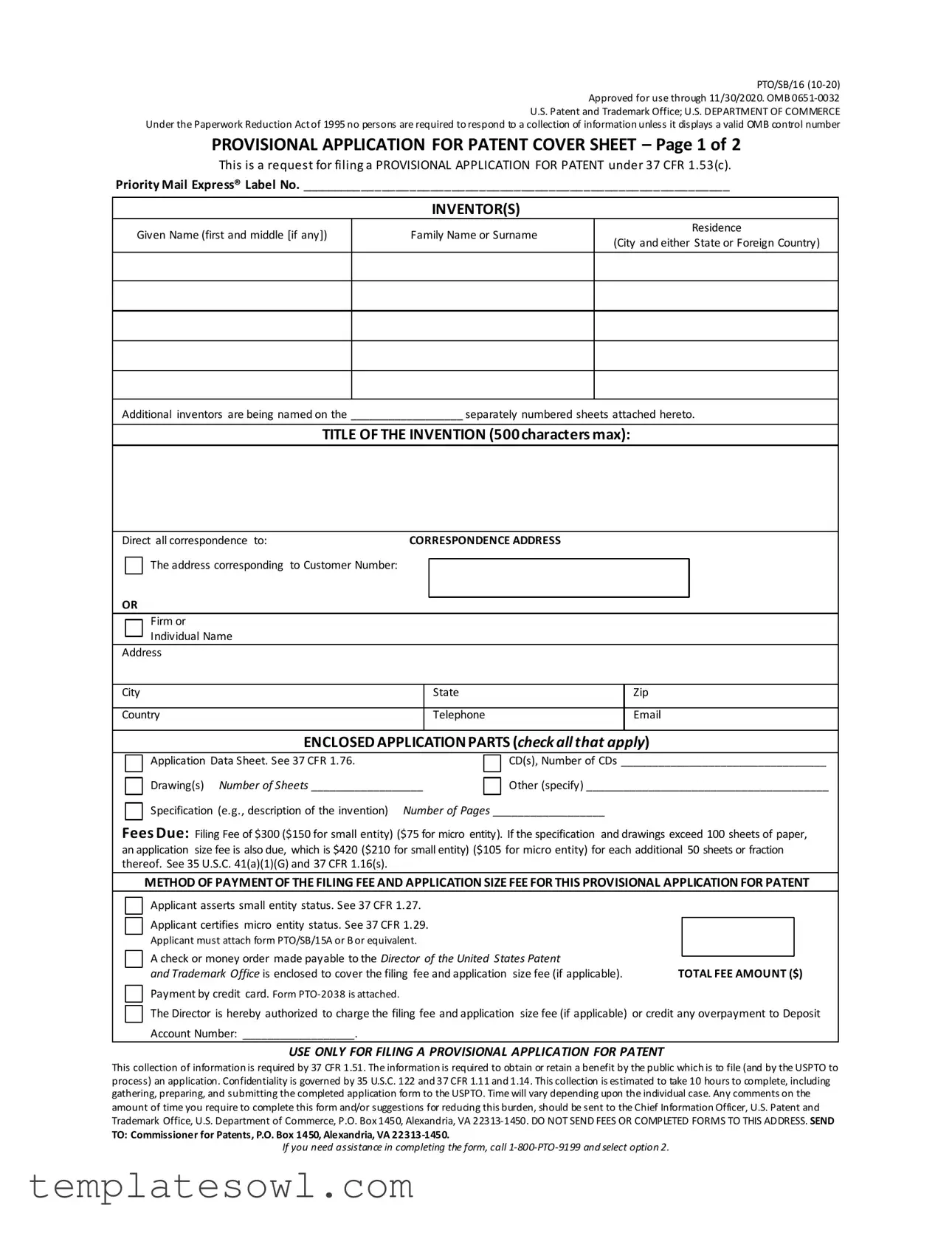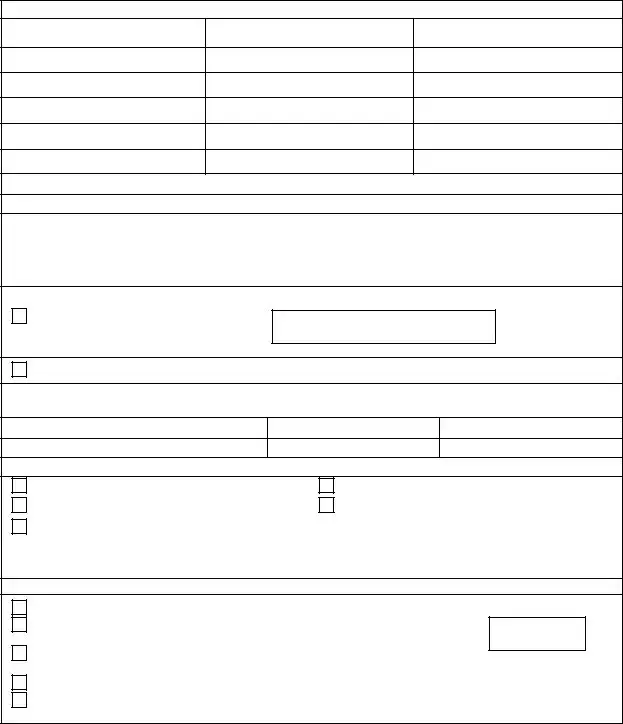PTO/SB/16 (10-20) Approved for use through 11/30/2020. OMB0651-0032 U.S. Patent and Trademark Office; U.S. DEPARTMENT OF COMMERCE
Under the Paperwork Reduction Act of 1995 no persons are required to respond to a collection of information unless it displays a valid OMB control number
PROVISIONAL APPLICATION FOR PATENT COVER SHEET – Page 1 of 2
This is a request for filing a PROVISIONAL APPLICATION FOR PATENT under 37 CFR 1.53(c). Priority Mail Express® Label No. ______________________________________________________________
INVENTOR(S)
Given Name (first and middle [if any])
Residence
(City and either State or Foreign Country)
Additional inventors are being named on the __________________ separately numbered sheets attached hereto.
TITLE OF THE INVENTION (500 characters max):
Direct all correspondence to: |
CORRESPONDENCE ADDRESS |
The address corresponding to Customer Number:
OR
Firm or
Individual Name
ENCLOSED APPLICATION PARTS (check all that apply)
Application Data Sheet. See 37 CFR 1.76.
Drawing(s) Number of Sheets __________________
CD(s), Number of CDs _________________________________
Other (specify) _______________________________________
Specification (e.g., description of the invention) Number of Pages __________________
Fees Due: Filing Fee of $300 ($150 for small entity) ($75 for micro entity). If the specification and drawings exceed 100 sheets of paper, an application size fee is also due, which is $420 ($210 for small entity) ($105 for micro entity) for each additional 50 sheets or fraction thereof. See 35 U.S.C. 41(a)(1)(G) and 37 CFR 1.16(s).
METHOD OF PAYMENT OF THE FILING FEE AND APPLICATION SIZE FEE FOR THIS PROVISIONAL APPLICATION FOR PATENT
Applicant asserts small entity status. See 37 CFR 1.27. |
|
Applicant certifies micro entity status. See 37 CFR 1.29. |
|
Applicant must attach form PTO/SB/15A or B or equivalent. |
|
A check or money order made payable to the Director of the United States Patent |
TOTAL FEE AMOUNT ($) |
and Trademark Office is enclosed to cover the filing fee and application size fee (if applicable). |
Payment by credit card. Form PTO-2038 is attached. |
|
The Director is hereby authorized to charge the filing fee and application size fee (if applicable) or credit any overpayment to Deposit Account Number: __________________.
USE ONLY FOR FILING A PROVISIONAL APPLICATION FOR PATENT
This collection of information is required by 37 CFR 1.51. The information is required to obtain or retain a benefit by the public which is to file (and by the USPTO to process) an application. Confidentiality is governed by 35 U.S.C. 122 and 37 CFR 1.11 and 1.14. This collection is estimated to take 10 hours to complete, including gathering, preparing, and submitting the completed application form to the USPTO. Time will vary depending upon the individual case. Any comments on the amount of time you require to complete this form and/or suggestions for reducing this burden, should be sent to the Chief Information Officer, U.S. Patent and Trademark Office, U.S. Department of Commerce, P.O. Box 1450, Alexandria, VA 22313-1450. DO NOT SEND FEES OR COMPLETED FORMS TO THIS ADDRESS. SEND
TO: Commissioner for Patents, P.O. Box 1450, Alexandria, VA 22313-1450.
If you need assistance in completing the form, call 1-800-PTO-9199 and select option 2.
PTO/SB/16 (10-20) Approved for use through 11/30/2020. OMB0651-0032 U.S. Patent and Trademark Office; U.S. DEPARTMENT OF COMMERCE
Under the Paperwork Reduction Act of 1995 no persons are required to respond to a collection of information unless it displays a valid OMB control number
PROVISIONAL APPLICATION FOR PATENT COVER SHEET – Page 2 of 2
The invention was made by an agency of the United States Government or under a contract with an agency of the United States Government. (NOTE: Providing this information on a provisional cover sheet, such as this Provisional Application for Patent Cover Sheet (Form PTO/SB/16), does not satisfy the requirement of 35 U.S.C. 202(c)(6), which requires that the specification contain a statement specifying that the invention was made with Government support and that the Government has certain rights in the invention.)
No.
Yes, the invention was made by an agency of the U.S. Government. The U.S. Government agency name is:
_____________________________________________________________________________________________________________
Yes, the invention was made under a contract with an agency of the U.S. Government.
The contract number is: _________________________________________________________________________________________
The U.S. Government agency name is: _____________________________________________________________________________
_____________________________________________________________________________________________________________
In accordance with 35 U.S.C. 202(c)(6) and 37 CFR 401.14(f)(4), the specifications of any United States patent applications and any patent issuing thereon covering the invention, including the enclosed provisional application, must state the following:
‘‘This invention was made with government support under [IDENTIFY THE CONTRACT] awarded by [IDENTIFY THE FEDERAL AGENCY]. The government has certain rights in the invention.”
WARNING:
Petitioner/applicant is cautioned to avoid submitting personal information in documents filed in a patent application that may contribute to identity theft. Personal information such as social security numbers, bank account numbers, or credit card numbers (other than a check or credit card authorization form PTO-2038 submitted for payment purposes) is never required by the USPTO to support a petition or an application. If this type of personal information is included in documents submitted to the USPTO, petitioners/applicants should consider redacting such personal information from the documents before submitting them to the USPTO. Petitioner/applicant is advised that the record of a patent application is available to the public after publication of the application (unless a non-publication request in compliance with 37 CFR 1.213(a) is made in the application) or issuance of a patent. Furthermore, the record from an abandoned application may also be available to the public if the application is referenced in a published application or an issued patent (see 37 CFR 1.14). Checks and credit card authorization forms PTO-2038 submitted for payment purposes are not retained in the application file and therefore are not publicly available.
SIGNATURE __________________________________________________________ |
DATE _________________________ |
TYPED OR PRINTED NAME ______________________________________________ |
REGISTRATION NO. ______________ |
|
(if appropriate) |
TELEPHONE __________________________________________ DOCKET NUMBER _______________________________
Privacy Act Statement
The Privacy Act of 1974 (P.L. 93-579) requires that you be given certain information in connection with your submission of the attached form related to a patent application or patent. Accordingly, pursuant to the requirements of the Act, please be advised that: (1) the general authority for the collection of this information is
35U.S.C. 2(b)(2); (2) furnishing of the information solicited is voluntary; and (3) the principal purpose for which the information is used by the U.S. Patent and Trademark Office is to process and/or examine your submission related to a patent application or patent. If you do not furnish the requested information, the U.S. Patent and Trademark Office may not be able to process and/or examine your submission, which mayresult in termination of proceedings or abandonment of the application or expiration of the patent.
The information provided byyou in this form will be subject to the following routine uses:
1.The information on this form will be treated confidentially to the extent allowed under the Freedom of Information Act (5 U.S.C. 552) and the Privacy Act (5 U.S.C 552a). Records from this system of records may be disclosed to the Department of Justice to determine whether disclosure of these records is required by the Freedom of Information Act.
2.A record from this system of records may be disclosed, as a routine use, in the course of presenting evidence to a court, magistrate, or administrative tribunal, including disclosures to opposing counsel in the course of settlement negotiations.
3.A record in this system of records may be disclosed, as a routine use, to a Member of Congress submitting a request involving an individual, to whom the record pertains, when the individual has requested assistance from the Member with respect to the subject matter of the record.
4.A record in this system of records may be disclosed, as a routine use, to a contractor of the Agency having need for the information in order to perform a contract. Recipients of information shall be required to complywith the requirements of the Privacy Act of 1974, as amended, pursuant to 5 U.S.C. 552a(m).
5.A record related to an International Application filed under the Patent Cooperation Treatyin this system of records may be disclosed, as a routine use, to the International Bureau of the World Intellectual Property Organization, pursuant to the Patent Cooperation Treaty.
6.A record in this system of records may be disclosed, as a routine use, to another federal agency for purposes of National Securityreview (35 U.S.C. 181) and for review pursuant to the Atomic Energy Act (42 U.S.C. 218(c)).
7.A record from this system of records maybe disclosed, as a routine use, to the Administrator, General Services, or his/her designee, during an inspection of records conducted byGSA as part of that agency’s responsibility to recommend improvements in records management practices and programs, under authority of 44 U.S.C. 2904 and 2906. Such disclosure shall be made in accordance with the GSA regulations governing inspection of records for this purpose, and any other relevant (i.e., GSA or Commerce) directive. Such disclosure shall not be used to make determinations about individuals.
8.A record from this system of records may be disclosed, as a routine use, to the public after either publication of the application pursuant to 35 U.S.C. 122(b) or issuance of a patent pursuant to 35 U.S.C. 151. Further, a record may be disclosed, subject to the limitations of 37 CFR 1.14, as a routine use, to the public if the record was filed in an application which became abandoned or in which the proceedings were terminated and which application is referenced by either a published application, an application open to public inspection or an issued patent.
9.A record from this system of records maybe disclosed, as a routine use, to a Federal, State, or local law enforcement agency, if the USPTO becomes aware of a violation or potential violation of law or regulation.


